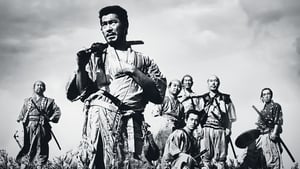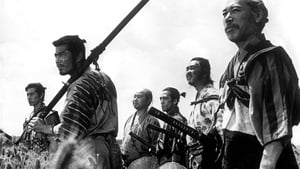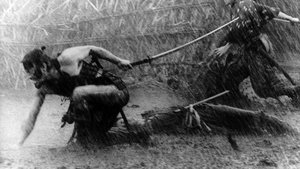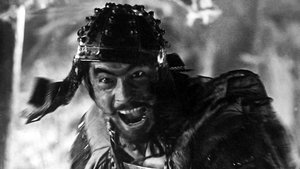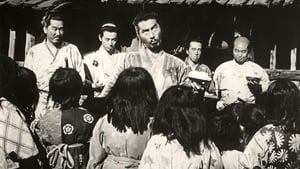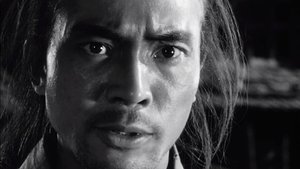Contact: [email protected]
Video Sources 0 Views
- Watch trailer
- Seven Samurai


Synopsis
Table of Contents
ToggleReview: Seven Samurai 1954 – A Masterpiece in Color and Contrast

Introduction
In the annals of cinema, few films stand as tall as Seven Samurai 1954. Directed by the legendary Akira Kurosawa, this epic tale of honor, sacrifice, and redemption has captivated audiences for generations. Now, with the release of its early colored version, viewers have the opportunity to experience Kurosawa’s masterpiece in a whole new light. In this review, we will delve into the impact of colorization on the viewing experience of Seven Samurai 1954 and its enduring significance in the world of cinema.
Check The Full Colorized Movies List
Check Our Colorized Movies Trailer Channel
Understanding Seven Samurai 1954: Director, Cast, and Genre
Akira Kurosawa’s vision for Seven Samurai 1954 was nothing short of revolutionary. Drawing inspiration from classical Japanese literature and Western filmmaking techniques, Kurosawa crafted a timeless tale of heroism and camaraderie set against the backdrop of feudal Japan. With a cast of iconic actors including Toshiro Mifune, Takashi Shimura, and Isao Kimura, Kurosawa brought his vision to life with unparalleled authenticity. Seven Samurai 1954 transcends genre classifications, seamlessly blending elements of action, drama, and romance to create a cinematic experience unlike any other.
Exploring the World of Seven Samurai 1954: Plot and Characters
Set in 16th-century Japan, Seven Samurai 1954 follows a small village terrorized by bandits who pillage their crops and threaten their way of life. Desperate for help, the villagers enlist the aid of seven masterless samurai, who agree to defend the village in exchange for food and shelter. As the samurai train the villagers and prepare for battle, bonds are forged, sacrifices are made, and the true meaning of honor is put to the test. Led by the enigmatic Kambei Shimada, played with stoic grace by Takashi Shimura, the samurai embark on a journey that will test their courage, skill, and loyalty to the very end.
The Art of Film Colorization
Film colorization is a process that has evolved significantly since its inception, allowing filmmakers to breathe new life into classic black and white films. By adding color to these timeless works, colorization aims to enhance the visual experience for modern audiences while preserving the integrity of the original film. From hand-tinted frames to advanced digital techniques, colorization has become an essential tool in the preservation and restoration of classic cinema.
Early Colored Films: A Brief History
The history of early colored films is a rich tapestry woven through the fabric of cinema. From the vibrant hues of Technicolor to the subtle tones of early digital colorization, filmmakers have continually sought to push the boundaries of visual storytelling and capture the imagination of audiences around the world. While early attempts at colorization were often crude and rudimentary, advancements in technology have allowed filmmakers to achieve increasingly lifelike results, paving the way for a new era of color cinema.
Seven Samurai 1954 and Its Early Colored Version
The decision to release Seven Samurai 1954 in a colorized format was met with both excitement and apprehension. While purists argued for the preservation of the film’s original black and white presentation, others welcomed the opportunity to experience Kurosawa’s masterpiece in vibrant color. Ultimately, the early colored version of Seven Samurai 1954 offers viewers a fresh perspective on the film’s timeless themes and iconic performances, inviting them to rediscover this cinematic gem in a whole new light. The lush colors and rich textures breathe new life into Kurosawa’s breathtaking cinematography, while adding depth and dimension to the film’s evocative visuals.
The Debate Over Film Colorization
The debate over film colorization is as old as the process itself, with proponents arguing for its artistic merit and accessibility, while detractors lament the potential loss of the original film’s aesthetic and mood. While both sides present valid arguments, the decision to colorize a film ultimately rests on the filmmaker’s vision and the audience’s reception. For some, colorization offers a chance to experience classic films in a new and exciting way, while for others, it represents a betrayal of the filmmaker’s original intent. Ultimately, the debate over film colorization is likely to continue for years to come, as filmmakers and audiences alike grapple with questions of authenticity, preservation, and artistic integrity.
Examining Seven Samurai 1954 as an Early Colored Film
As an early colored film, Seven Samurai 1954 offers a unique opportunity to explore the intersection of technology and artistry. While some may argue that colorization detracts from the film’s original aesthetic, others contend that it enhances the viewing experience, bringing new depth and dimension to Kurosawa’s masterful storytelling. Indeed, the early colored version of Seven Samurai 1954 adds an extra layer of richness and complexity to the film’s breathtaking visuals, allowing audiences to see familiar scenes in a whole new light. Whether experienced in its original black and white format or its early colored incarnation, Seven Samurai 1954 remains a timeless masterpiece that continues to resonate with audiences around the world.
Influence and Legacy: Seven Samurai 1954’s Impact on Cinema
Seven Samurai 1954 has left an indelible mark on the cinematic landscape, inspiring generations of filmmakers and setting the standard for epic storytelling. From its breathtaking battle scenes to its poignant character moments, the film has captivated audiences with its timeless themes of courage, honor, and sacrifice. Kurosawa’s influence can be seen in the work of filmmakers around the world, from Hollywood blockbusters to independent arthouse films. Notably, the Western remake trend sparked by Seven Samurai 1954 paved the way for classics such as The Magnificent Seven and A Fistful of Dollars, solidifying the film’s status as a cultural touchstone.
Director’s Cinematic Legacy: Beyond Seven Samurai 1954
Akira Kurosawa’s cinematic legacy extends far beyond Seven Samurai 1954, encompassing a diverse range of films that continue to captivate audiences to this day. From his groundbreaking collaborations with Toshiro Mifune to his epic historical dramas, Kurosawa’s influence on local and international filmmaking is undeniable. Throughout his illustrious career, Kurosawa pushed the boundaries of visual storytelling, challenging audiences to see the world in new and unexpected ways. His unique blend of style and substance has left an indelible mark on the world of cinema, inspiring countless filmmakers to follow in his footsteps and forge their own paths to greatness.
Themes Explored in Seven Samurai 1954
Seven Samurai 1954 explores a myriad of themes, from the nature of heroism to the fragility of human connection. Through its richly drawn characters and intricately woven plot, the film invites audiences to ponder timeless questions of honor, duty, and sacrifice. Kurosawa’s masterful direction and breathtaking cinematography serve to underscore the film’s themes, creating a sense of tension and urgency that permeates every frame. From its haunting opening sequence to its heartbreaking climax, Seven Samurai 1954 offers a profound meditation on the human condition and the eternal struggle for justice and redemption.
Reception and Controversy Surrounding Seven Samurai 1954
Upon its release, Seven Samurai 1954 received widespread critical acclaim for its breathtaking visuals, epic scope, and powerful performances. However, the decision to release the film in a colorized format sparked controversy among cinephiles, with some praising the enhanced visual experience while others lamented the potential loss of the film’s original aesthetic. Despite the controversy, Seven Samurai 1954 remains a beloved classic that continues to resonate with audiences around the world. Whether viewed in its original black and white format or its early colored incarnation, the film’s timeless themes and iconic imagery ensure its enduring appeal for generations to come.
Where to Watch Seven Samurai 1954 Online
For those eager to experience the magic of Seven Samurai 1954, the film is available for streaming on popular platforms such as Amazon Prime Video and Google Play Movies. Whether you choose to watch it in its original black and white format or its early colored version, Seven Samurai 1954 promises to captivate and enthrall audiences with its timeless tale of honor, sacrifice, and redemption.
FAQs About Seven Samurai 1954
- Is Seven Samurai 1954 based on a true story? No, Seven Samurai 1954 is a work of fiction inspired by real-life events and characters. While the film’s setting and premise draw from historical elements of feudal Japan, the story itself is a product of director Akira Kurosawa’s imagination.
- Who plays the lead role in Seven Samurai 1954? The lead role of Kambei Shimada, the wise and honorable leader of the seven samurai, is portrayed by the incomparable Takashi Shimura. Known for his versatility and depth as an actor, Shimura’s portrayal of Kambei remains one of the most iconic performances in cinema history.
- What is the significance of the film’s early colored version? The early colored version of Seven Samurai 1954 offers viewers a fresh perspective on the film’s timeless themes and iconic performances. By adding color to the film’s stunning visuals, the early colored version enhances the viewing experience, immersing audiences in the vibrant world of feudal Japan while preserving the integrity of Kurosawa’s original vision.
- How does Seven Samurai 1954 compare to other samurai films of its time? Seven Samurai 1954 is widely regarded as one of the greatest samurai films ever made, setting a new standard for epic storytelling and character-driven drama. While other samurai films of the era focused primarily on action and spectacle, Seven Samurai 1954 distinguished itself with its richly drawn characters, intricate plot, and profound exploration of themes such as honor, sacrifice, and redemption.
- What impact did Seven Samurai 1954 have on the world of cinema? Seven Samurai 1954 has had a profound and lasting impact on the world of cinema, influencing generations of filmmakers and setting the standard for epic storytelling. The film’s innovative techniques, richly drawn characters, and timeless themes have inspired countless adaptations, remakes, and homages, cementing its status as a cultural touchstone and cinematic masterpiece.
- Why is Seven Samurai 1954 considered a timeless classic? Seven Samurai 1954 is considered a timeless classic for its universal themes, masterful storytelling, and groundbreaking filmmaking techniques. From its epic battle scenes to its poignant character moments, the film continues to resonate with audiences of all ages, offering a profound meditation on the nature of heroism, sacrifice, and the human condition.
- What makes Seven Samurai 1954 relevant to modern audiences? Despite being released over half a century ago, Seven Samurai 1954 remains as relevant and compelling as ever. Its exploration of timeless themes such as honor, duty, and loyalty transcends the boundaries of time and culture, offering a powerful and resonant commentary on the human experience that continues to captivate audiences around the world.
Conclusion
Seven Samurai 1954 stands as a towering achievement in the world of cinema, a timeless masterpiece that continues to inspire and captivate audiences around the world. Whether experienced in its original black and white format or its early colored incarnation, the film’s timeless themes and breathtaking visuals ensure its enduring appeal for generations to come. As we reflect on the legacy of Seven Samurai 1954 and the ongoing debate surrounding film colorization, one thing remains clear: the power of great storytelling knows no bounds, and its impact on the world of cinema will continue to be felt for generations to come. So, grab your popcorn, dim the lights, and immerse yourself in the timeless world of Seven Samurai 1954 – you won’t be disappointed.
